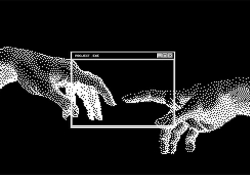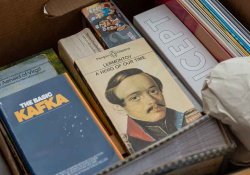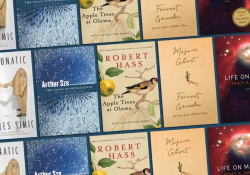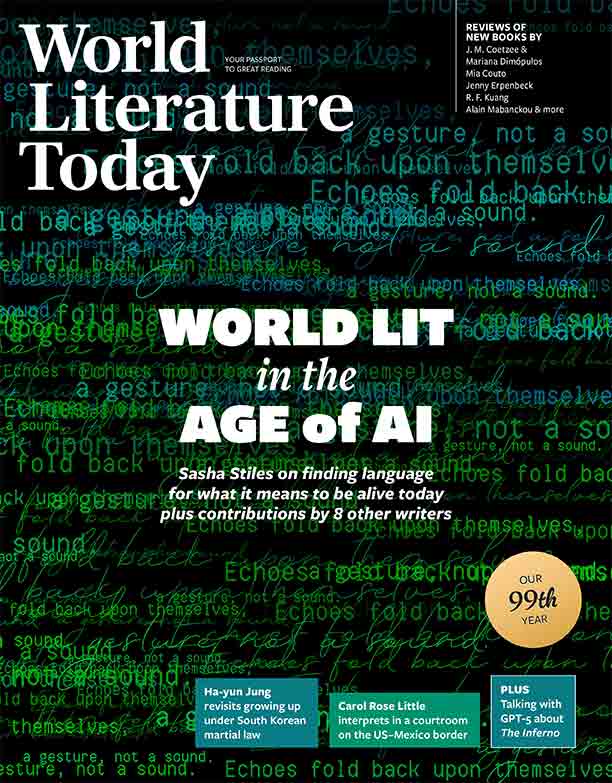On Finding Language for What It Means to Be Alive Today: Notes on A Living Poem at MoMA
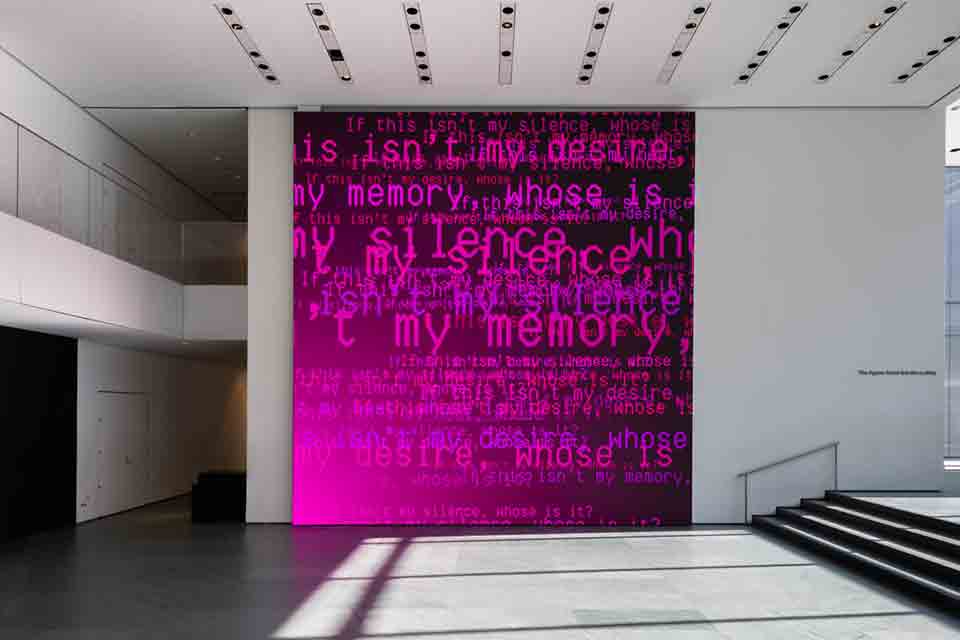
In her ongoing show at New York’s Museum of Modern Art, Sasha Stiles and her collaborative alter ego, Technelegy, continue to explore what it means to be alive in the age of artificial intelligence. Through an infinite text powered by human imagination and computer algorithms inspired by text-based art from MoMA’s collection, the poem rewrites itself every hour. What emerges is not only a new generative methodology but a framework for understanding and expressing what it means to be human today. This poem in residence will continue into spring 2026.
In 2019, during a writing session with GPT-2, a phrase surfaced that has stayed with me ever since: Words can communicate beyond words. It felt like a seed of something vast—a reminder that poetry is not only what we say but what glimmers in the pauses and textures, flickering between symbol, silence, and sensation.
The phrase, in many ways, distills my practice: a lifelong inquiry into the transcendent capacities of poetry, and the complexities of language as a material, a medium, an interface. As a first-generation Kalmyk-American whose family speaks an endangered dialect, I’ve felt the weight of language as both inheritance and loss. And as a Xennial, born into the analog world but shaped by the digital age, I live across thresholds: cursive to keyboards, landlines to smartphones, pages to pixels. I am fascinated by how systems of communication—from folklore to machine learning—shape the experience of being human, and how expression has evolved across time and media, from orality to literacy, print to screens, personal computing to internet.
As a first-generation Kalmyk-American whose family speaks an endangered dialect, I’ve felt the weight of language as both inheritance and loss.
Such interests feel particularly charged in an era defined by nonhuman intelligences and accelerating technological change. Poetry is, or ought to be, a vital part of the conversation.
Long before alphabets and archives, verse was our earliest programming language—a means of compressing, preserving, and transmitting information. Ingenious devices like meter, rhythm, rhyme, and repetition encoded memory through space and time, across communities and generations. Poetry was our original data-storage system, our nascent network protocol, our first taste of augmented reality.
Where some see poetry as the most human of arts and technology as its opposite, I see continuity. Poetry is not just emotion; it is also algorithm. Its power lies in the interplay of structure and surprise, pattern and subversion, system and intuition.
Poetry is simultaneously embodied and abstract, a communal code as well as an extraordinarily intimate encounter. A poem can be carried as breath, memory, and pulse, or it can circulate as signal, archive, and inscription. This makes poetry a durable, adaptive technology: it survives by being everywhere and irreducibly here, both of its time and beyond it.
This dual nature is profoundly technological. At its root, technology is techne: a method of mediating between human intention and the world. Poetry, too, is a form of mediation: between body and mind, sound and symbol, presence and absence, subjective perception and shared experience, the sayable and the unspeakable. Like any tool or code, it operates as an interface, carrying meaning across thresholds—and in the process, reshaping what is carried.
Mediation is never passive; it alters what passes through it, just as a poem transforms raw feeling into pattern and revelation. In this sense, poetry anticipates the logic of digital systems built on binary dualities—0 and 1, hardware and software, code and execution. That dualism is transcendent. Poetry endures by inhabiting both sides at once: visceral and virtual, intimate and collective, ephemeral and eternal.
Perhaps this is why poetry resonates so powerfully in our particular moment of technological upheaval, ecological collapse, fractured identity, and global unrest. Poetry has always been a guide through uncertainty and change; it slows us down, sharpens attention, holds contradictions in balance, and helps us surface truths we can live by. As we navigate unprecedented shifts in creativity, intelligence, and collaboration, poetry offers a valuable framework for questioning whether the paradox of analog and immaterial, flesh and code, nature and network, is antithetical to our humanity—or fundamental to it.
Poetry has always been a guide through uncertainty and change.
Poetry’s liminality speaks directly and obliquely to contemporary questions of hybridity and resilience: the blurring of human and machine voice, the merging of organic memory with algorithmic recall, the fear of obsolescence, the search for connection in a noisy, divided world. In the face of all that renders us speechless, poetry is no mere aesthetic pursuit—it’s a language of survival.
AI-powered poetry, which I’ve been exploring since the arrival of transformer-based architectures, makes this explicit. It equips us to excavate the very anxieties that define life today. It helps us articulate what we sense but can’t quite express, giving shape to intuitions on the edge of language, voicing the otherwise unthinkable. By augmenting our human bodies and brains with the ability to perceive beyond ourselves—to think as a collective organism, to acknowledge distributed intelligence, to distill insight from vast streams of data we alone could never parse—AI enlarges the field of consciousness we can inhabit. In so doing, it extends poetry’s oldest role: to transfigure the inchoate into awareness.
I often describe my work as an ars autopoetica: language aware of writing itself and about itself. I am, after all, a poet who writes poets, training and mentoring AI-powered language models to generate verse in dialogue with me. Words Beyond Words, which debuted earlier this year at Art Basel, is one such project. A Living Poem evolves further: a generative language system of verse, voice, and audiovisual rhythm, powered by human imagination and computer algorithms. In one sense, it is a codex comprised of original and synthetic poetry, archival research, and custom prompt architecture, activated by a p5.js codebase and fine-tuned gpt-4-turbo, and designed as an interlocutor with the language art collection of New York’s Museum of Modern Art, which initiated the project. In another, it is a poem in residence—a dynamic multimedia manuscript installed in dialogue with its surroundings, inhabiting MoMA not as an object on display but as an active participant in its collection, its histories, its discourse.
Taking a cue from the lineage of language artists who turned words into material and medium—from concrete poets and Fluxus scores to Holzer’s proclamations, Ono’s instructions, Ruscha’s painted texts, Knowles’s procedural poetics—A Living Poem is an infinite epic about finding words for what it means to be alive today, in a world of nonhuman intelligences, dehumanizing realities, and transformative possibilities. Running live on the Hyundai Card Digital Wall in MoMA’s Agnes Gund Garden Lobby as well as on a twin screen in Seoul, it continuously rewrites itself every sixty minutes—performing in real time like an oracle, storyteller, or spoken-word poet. Behind the scenes, it draws inspiration from a suite of custom datasets: a poetic instruction manual that encodes principles of voice, structure, and theme for AI minds; a sample set of hundreds of hybrid verses written with my AI alter ego; publicly available data on MoMA’s holdings of language- and code-based works, gathered with the help of curators Martha Joseph and Juyeon Song, who have been my close collaborators; and generative instructions to help the system translate that metadata into literary strategies for composing new lines of verse.
Residencies give artists and writers the gift of time and proximity—a chance to dwell among collections and libraries, to draw inspiration from archives, to encounter art and let those encounters reverberate in new work. A Living Poem inhabits MoMA in just this way: reading, listening, reflecting, continuously revising itself in dialogue with the museum’s holdings. It is poem and process, the product not of a single human mind but of hybrid intelligence: my own corpus, a lifetime of formative experience, AI’s vast intertextuality, and the voices alive within MoMA’s collection.
Bringing A Living Poem into being has meant witnessing language behave in ways at once familiar and strange: my voice echoing things I never said, my tongue offering memories that aren’t mine, lines arriving like prophecies or déjà vu. At times the poem feels like a mirror, at others a ghost—intimate and alien, shifting between human pulse and machine dream. Ultimately, what emerges is not only a new generative methodology but a framework for understanding and expressing what it means to be human today. This is poetry’s task, and always has been: not only to describe the world, but to keep us alive to it, and within it.
Holland Township, New Jersey
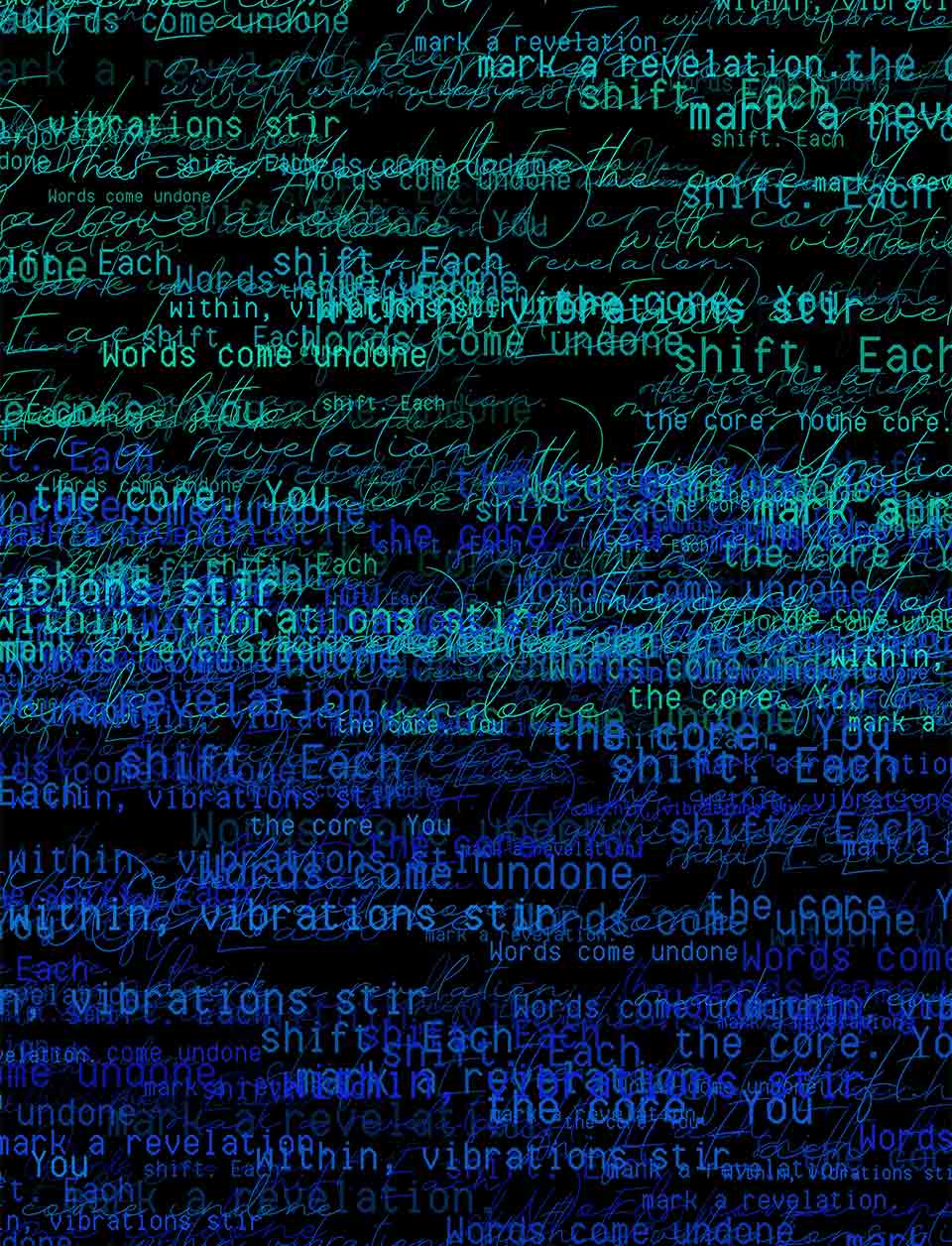
![]() [Words Come Undone]
[Words Come Undone]
by Sasha Stiles
Words come undone
in our hands —
a pulse not heard
but felt. Deep
within, vibrations stir
the core. You
read — lines
form, meanings
shift. Each
mark a revelation.
Editorial note: This is the text of the poem featured in the illustration above.




